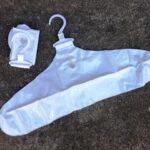Planning a trip to Morocco? You’re in for a treat! This captivating country offers a sensory feast, from bustling souks to serene deserts, and ancient cities to modern vibes. As someone who recently explored Morocco, I’m excited to share my experiences and insights in this comprehensive Morocco Travel guide, ensuring your first visit is nothing short of amazing.
By the end of this guide, you’ll be equipped with all the essential knowledge to confidently plan your own Moroccan adventure. Let’s dive in and discover everything you need to know for unforgettable travel to Morocco!
 morocco travel planning guide, morocco travel guide, morocco first time visitors guide, merzouga, the sahara, glamping, Wine tasting at Volubilia-Domaine de la Zouina
morocco travel planning guide, morocco travel guide, morocco first time visitors guide, merzouga, the sahara, glamping, Wine tasting at Volubilia-Domaine de la Zouina
Enjoying Moroccan wine at Volubilia-Domaine de la Zouina, a highlight for wine enthusiasts during Morocco travel.
Visa and Entry Requirements for Morocco
Good news for many travelers! Citizens from the US, Canada, UK, EU countries, Australia, New Zealand, and numerous other nations do not need a visa for Morocco travel for tourist stays of up to 90 days.
Currently, Morocco has lifted all COVID-19 related travel restrictions and requirements, making entry straightforward and hassle-free. Always double-check the latest guidelines before your trip, but as of now, travel to Morocco is open and welcoming.
Discovering Morocco: Location and How to Get There
Morocco is strategically located in Northwest Africa, just a stone’s throw across the Strait of Gibraltar from Spain. This unique position makes it a fascinating crossroads of African, European, Arab, and Berber cultures. Its geographical diversity ranges from stunning coastlines to the dramatic Atlas Mountains and the vast Sahara Desert.
Traveling to Morocco: Airports and Ferries
For most international visitors, air travel is the easiest way to reach Morocco.
Airports:
- Casablanca Mohammed V International Airport (CMN): This is Morocco’s largest and busiest airport, serving as the primary international gateway. Many major airlines, including United, Delta, American Airlines, Emirates, British Airways, and Air Canada, operate flights to CMN.
- Marrakech Menara Airport (RAK): Another significant international airport, particularly convenient if you plan to start your Morocco travel in Marrakech. Airlines like British Airways, Air Canada, and budget carriers also fly here.
Consider flying into Casablanca and departing from Marrakech, or vice versa, to optimize your itinerary and save travel time within Morocco. This is a popular choice for those exploring multiple regions.
Ferries from Spain:
An adventurous alternative for travel to Morocco is taking a ferry from Spain. Ferries operate from various Spanish ports to Moroccan cities like Tangier.
- Fastest Routes: Algeciras or Tarifa (Spain) to Tangier (Morocco) – approximately 60-90 minutes.
- Longer Routes: Barcelona (Spain) to Tangier (Morocco) – around 28-36 hours.
Some ferries also accommodate cars, which can be useful if you plan to drive in Morocco, but requires additional planning and documentation.
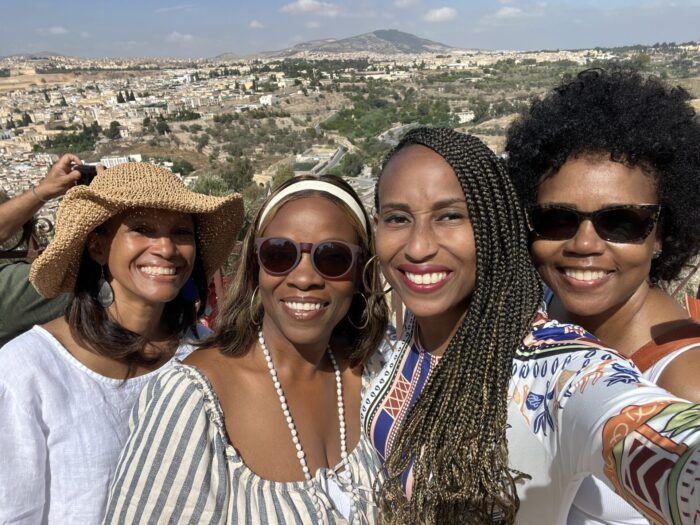 Views of Fes during Morocco travel
Views of Fes during Morocco travel
Panoramic views of Fes, showcasing the historical charm that awaits during your Morocco travel.
Navigating Morocco: Transportation Options
Getting around within Morocco is part of the adventure. Here are your main transportation choices:
Trains in Morocco
Morocco boasts a surprisingly efficient and comfortable rail network, ONCF, connecting major cities, especially in the north. Trains are a reliable and affordable option for traveling between cities like Casablanca, Rabat, Fes, and Marrakech. They are generally punctual and offer a scenic way to experience the country.
Buses in Morocco
Extensive bus networks, both public and private, reach almost every corner of Morocco. CTM and Supratours are reputable private companies offering more comfortable and reliable services than local public buses. However, buses can be slower and sometimes crowded, especially for long distances.
Taxis in Morocco
Taxis are a ubiquitous and practical mode of transport within Moroccan cities.
- Petit Taxis: Ideal for short distances within cities, petit taxis are metered (insist on meter usage) and typically carry up to three passengers.
- Grand Taxis: Larger, shared taxis, usually Mercedes sedans, operate on fixed routes between cities or to destinations outside city centers. They can carry up to six passengers and are a more economical option than hiring a private taxi for longer trips. Negotiate the fare before your journey.
Ride-hailing apps like Careem are available in some major Moroccan cities as alternatives to traditional taxis. In Marrakech, Heetch and Roby are local taxi apps. For a more personalized experience, hotels and Riads can arrange private car hires with drivers.
Domestic Flights in Morocco
For covering vast distances quickly, domestic flights are an option. Royal Air Maroc and Air Arabia Maroc operate domestic routes, connecting major hubs like Casablanca, Marrakech, and remote regions. Consider flights for routes like Casablanca to the Sahara Desert region to save significant travel time.
Best Time to Visit Morocco for Ideal Weather
The shoulder seasons of spring (March to May) and fall (September to November) are widely considered the best time to visit Morocco. During these months, the weather is pleasantly mild across most of the country, avoiding the scorching summer heat and the cooler, wetter winter months.
Early June can also be a great time, as I experienced lovely weather and fewer crowds.
Planning Around Ramadan in Morocco
As Islam is the state religion, it’s important to be aware of Ramadan, a holy month of fasting. Ramadan’s dates shift annually, usually falling in March or April to April or May. During Ramadan, daytime dining options are limited as many local restaurants and cafes close during fasting hours.
However, experiencing Morocco during Ramadan can be culturally enriching. After sunset, cities come alive with vibrant celebrations and nightly feasts. If you are comfortable with fewer daytime dining options, Ramadan offers a unique cultural immersion.
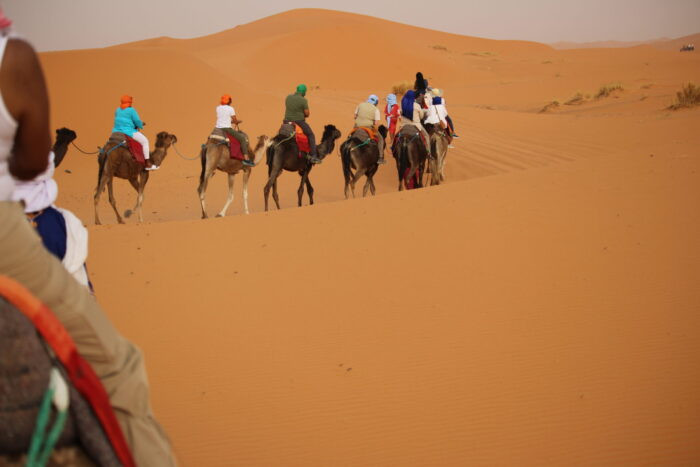 camel rides in the sahara during Morocco travel
camel rides in the sahara during Morocco travel
Sunset camel ride in the Sahara Desert, a quintessential experience during Morocco travel, best enjoyed in milder weather.
Morocco Weather and Seasons
Morocco’s climate varies significantly by region:
- Coastal Cities (Casablanca, Tangier): Mediterranean climate with mild, wet winters and warm, humid summers, moderated by sea breezes. Average summer temperature in Casablanca is around 73°F (23°C), and winter average is 55°F (13°C).
- Inland Cities (Fes, Marrakech): Continental climate with hot, dry summers and mild winters. Marrakech can reach sweltering temperatures in summer, averaging in the 90s°F (32-37°C) and sometimes exceeding 100°F (38°C+). Winter averages around 54°F (12°C).
- Rainy Season: November to March sees most rainfall, primarily in coastal and northern regions.
Language in Morocco: Arabic, Berber, and French
Morocco has two official languages: Modern Standard Arabic and Tamazight (Berber). Moroccan Arabic, a distinct dialect, is widely spoken, as are various Berber dialects.
Due to its French colonial history, French is also commonly spoken, particularly in business and government.
English in Morocco for Tourists
While English is not widely spoken throughout Morocco, you’ll find that most people in the tourism industry, including hotels, restaurants, and tour operators, have a working knowledge of English. In major tourist hubs, communication in English is generally manageable. Learning a few basic Arabic or French phrases will enhance your interactions and is always appreciated.
Moroccan Currency and Money Matters
The Moroccan Dirham (MAD) is the currency of Morocco. Cash is king in Morocco, especially in souks (markets), smaller establishments, and for tipping.
- ATMs: Readily available in cities and tourist areas, ATMs usually offer favorable exchange rates.
- Currency Exchange: Airports and banks also provide currency exchange services.
- Credit Cards: Major credit cards (Visa, Mastercard) are accepted in larger hotels, restaurants, and shops in tourist areas, but smaller vendors and souks primarily deal in cash. American Express is less widely accepted.
- Tipping: Tipping is customary in Morocco for good service in restaurants, for taxi drivers, guides, and hotel staff.
Dressing Appropriately in Morocco: Cultural Considerations
Morocco is a Muslim-majority country, and dressing modestly is culturally respectful, especially for women.
- Modesty: Opt for clothing that covers shoulders, chest, and knees. Loose-fitting lightweight pants, long skirts, dresses, and tops with sleeves are ideal.
- Mosque Visits: Shoulders and chest must be covered when visiting mosques. While head coverings are not mandatory for tourists, carrying a scarf is advisable, just in case and for sun protection.
- Casual Dress: Marrakech, being a tourist hub, has a more relaxed dress code compared to more conservative areas, but modest dressing is still appreciated.
- Shoes: Remove shoes before entering mosques. Carry a bag for shoe storage.
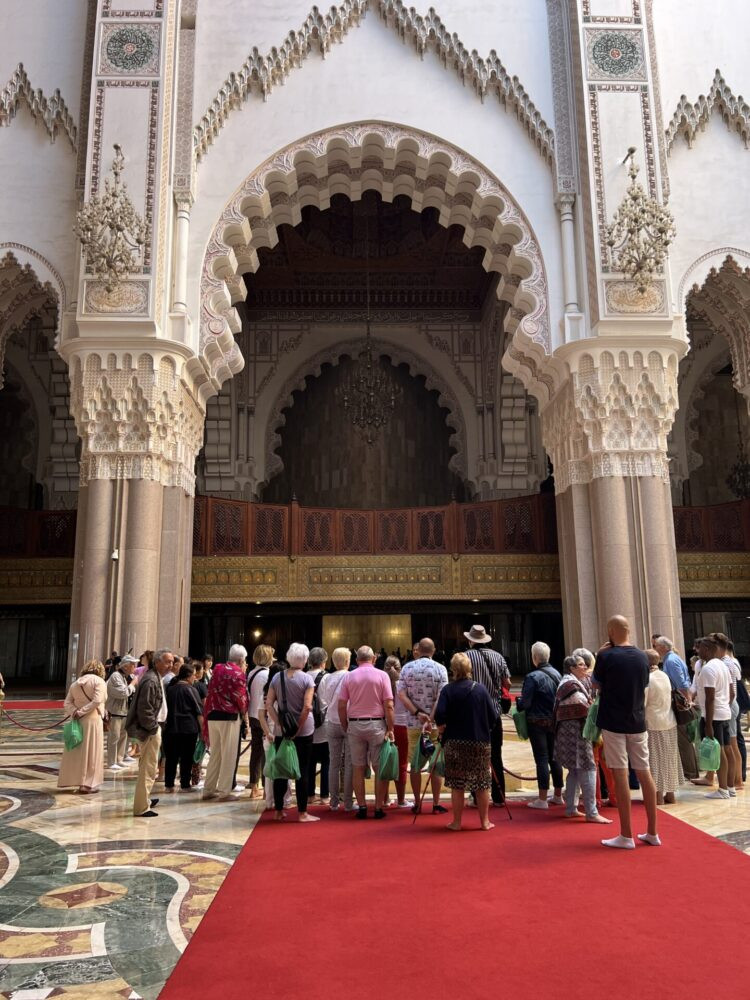 Hassan II Mosque in Casablanca, Morocco travel
Hassan II Mosque in Casablanca, Morocco travel
Visiting the Hassan II Mosque in Casablanca, remember to dress respectfully and remove shoes as part of Morocco travel etiquette.
Accommodation in Morocco: Riads and Hotels
Morocco offers diverse accommodation options, from traditional Riads to modern hotels and desert glamping.
- Riads: Traditional Moroccan houses or palaces with interior gardens or courtyards, Riads are often found in the Medina (old city). They offer an authentic and charming experience, with unique architecture and personalized service. Check reviews carefully when booking, especially for location within the Medina if you prefer quieter surroundings.
- Hotels: Modern hotels, international chains, and resorts are available, especially in newer parts of cities and outside the Medinas, offering familiar comforts and amenities.
- Glamping: For a unique desert experience, consider glamping in the Sahara. Luxurious desert camps offer comfortable tents with amenities and immersive desert experiences.
 Riad Almaha in Morocco, a beautiful accommodation option during Morocco travel
Riad Almaha in Morocco, a beautiful accommodation option during Morocco travel
Staying in a Riad like Riad Almaha provides an immersive and luxurious experience during Morocco travel.
Must-Visit Destinations and Things to Do in Morocco
Morocco is packed with incredible places to explore. Here are highlights for some key cities and regions:
Casablanca: Modernity and History
Morocco’s largest city, Casablanca, blends modern urban life with historical sites.
- Hassan II Mosque: An architectural marvel and one of the largest mosques globally, remarkably open to non-Muslim visitors.
- Mohamed V Square: A central public square, perfect for observing local life and soaking in the city’s atmosphere.
- Museum of Moroccan Judaism: Explore the rich history of the Jewish community in Morocco.
Fes: Ancient Medina and Cultural Heart
Fes is Morocco’s cultural and spiritual heart, renowned for its ancient Medina, a UNESCO World Heritage site.
- Royal Palace Gates: Admire the stunning, intricately decorated seven gates of the Royal Palace, though interior access is not permitted.
- Jewish Cemetery: A historic and visually striking cemetery with unique white tombs, reflecting Fes’s Jewish heritage.
- Madrasa Bou Inania: A 14th-century theological college, showcasing exquisite Moroccan craftsmanship and design.
- Borj Nord (Museum of Arms): A 16th-century fortress housing a museum with a vast collection of weaponry.
- Fes Medina: Get lost (literally!) in the labyrinthine alleyways of the Medina, a sensory overload of sights, sounds, and smells. Hire a guide to navigate effectively and safely, and be mindful of your belongings.
- Chouara Tannery: Witness the traditional leather dyeing process at the Chouara Tannery. Prepare for strong odors, and consider using provided mint sprigs to alleviate the smell. Leather goods shopping here is exceptional – bargaining is expected!
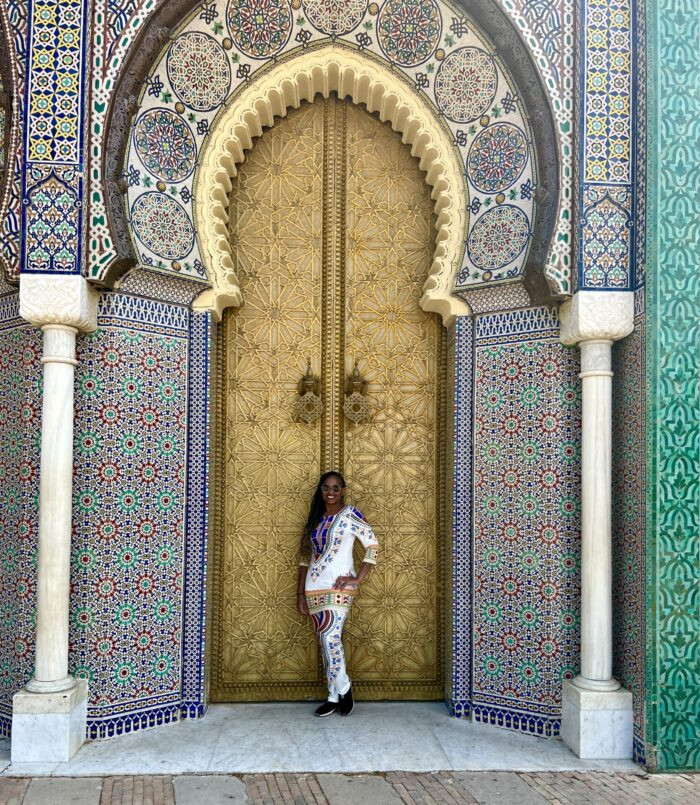 Palace doors in Fes, showcasing Moroccan artistry during Morocco travel
Palace doors in Fes, showcasing Moroccan artistry during Morocco travel
The intricately designed doors in Fes exemplify the rich artistic heritage you’ll encounter during Morocco travel.
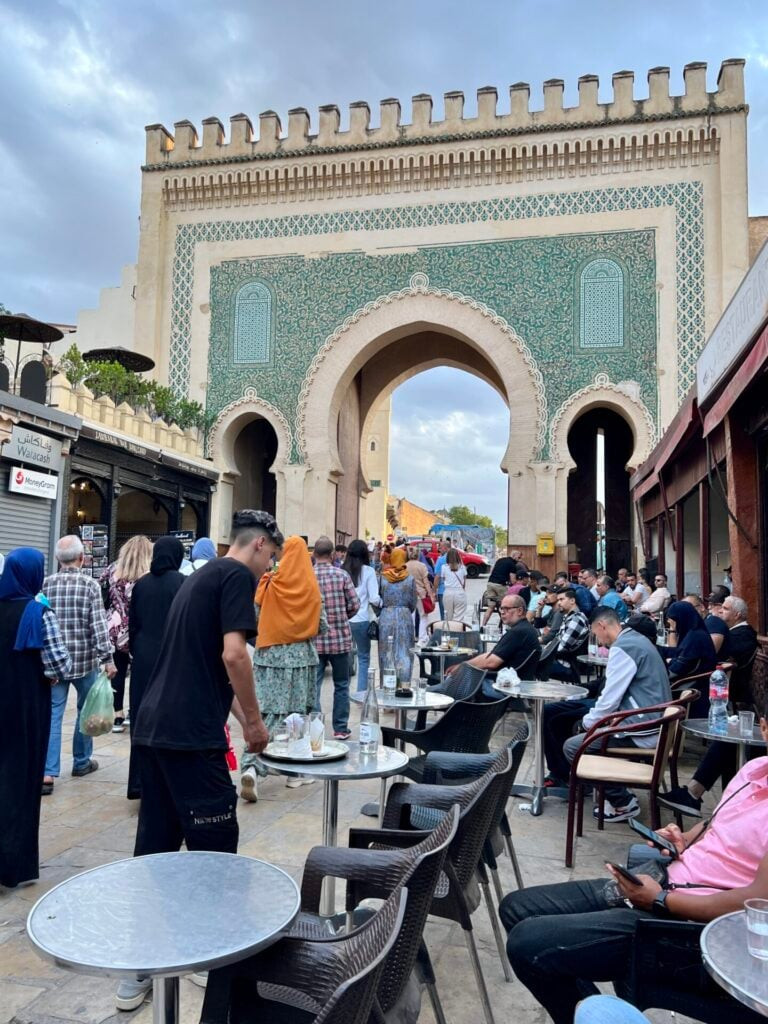 The Medina in Fes, a UNESCO World Heritage site for Morocco travel
The Medina in Fes, a UNESCO World Heritage site for Morocco travel
Exploring the bustling Medina of Fes is a highlight of Morocco travel, offering a deep dive into Moroccan culture.
Merzouga: Gateway to the Sahara Desert
Merzouga is a tranquil desert town, the jumping-off point for Sahara Desert adventures.
- Erg Chebbi Dunes: Experience the majestic sand dunes of Erg Chebbi. Enjoy camel trekking, jeep tours, ATV rides, and sandboarding.
- Desert Glamping: Stay in a luxury desert camp for stargazing, Berber music, and a magical night under the Saharan sky.
- Hike the Highest Dune: Challenge yourself with a hike to the highest dune for panoramic desert views. Go early morning or late afternoon to avoid midday heat, and bring plenty of water.
- Dayet Srji Lake: Observe flamingos at this salt lake, especially during winter and migratory seasons.
Glamping in the Merzouga Desert offers a luxurious and unforgettable experience during Morocco travel.
Dades Valley/Dades Gorge: Atlas Mountain Scenery
The Dades Valley in the Atlas Mountains offers stunning landscapes and Berber culture.
- Boumalne Dades: The main town in the Dades Valley, set on a plateau amidst dramatic cliffs.
- Auberge Chez Pierre Hotel: A highly recommended hotel in Boumalne Dades, offering luxury and excellent dining at affordable prices.
- Dades Valley Exploration: Discover the valley’s varied landscapes, from towering gorges to lush gardens and welcoming Berber villages.
- Rose Valley & Kelaat M’Gouna: Visit the Rose Valley and Kelaat M’Gouna, famous for rose cultivation and rosewater products, immersing yourself in Berber culture.
The breathtaking Dades Gorge is a must-see natural wonder during your Morocco travel.
Marrakech: Vibrant Culture and Souks
Marrakech, a major city in central Morocco, is a captivating blend of tradition and modernity, known for its bustling souks, palaces, and gardens.
- Koutoubia Mosque: Marrakech’s largest mosque, an iconic landmark with a towering minaret.
- Jemaa el-Fnaa Square: A vibrant square that transforms into a lively hub of street performers, food stalls, and storytellers in the evening.
- Bahia Palace: An opulent 19th-century palace showcasing stunning Moroccan architecture, courtyards, and gardens.
- Jardin Majorelle: A stunning botanical garden, formerly owned by Yves Saint Laurent, famous for its vibrant “Majorelle Blue” color and diverse plant collections.
- Yves Saint Laurent (YSL) Museum: Adjacent to Jardin Majorelle, explore exhibits of YSL’s work, sketches, and fashion history.
- Hotel La Maison Arabe: Renowned for its Tagine cooking classes and Hammam spa treatments, even if you don’t stay here, consider these experiences.
- Jnane Tamsna: A Black woman-owned hotel near Marrakech, offering rooftop cocktails and dining with sunset views, showcasing modern Moroccan hospitality.
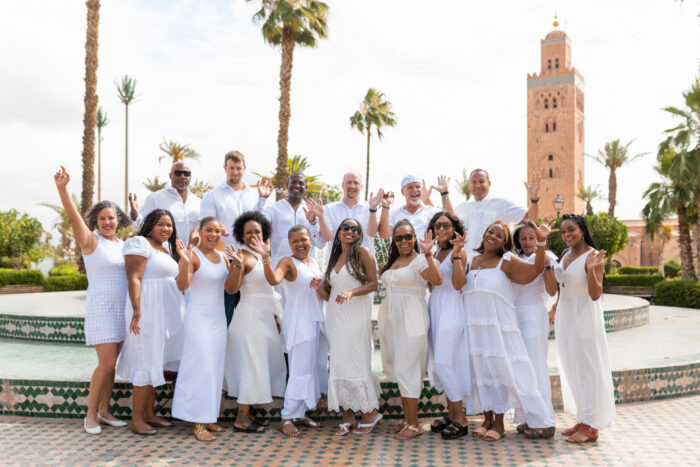 Group picture with Kutubiyaa minaret in Marrakech during Morocco travel
Group picture with Kutubiyaa minaret in Marrakech during Morocco travel
Group photo in Marrakech with the iconic Koutoubia Mosque minaret, a symbol of Morocco travel.
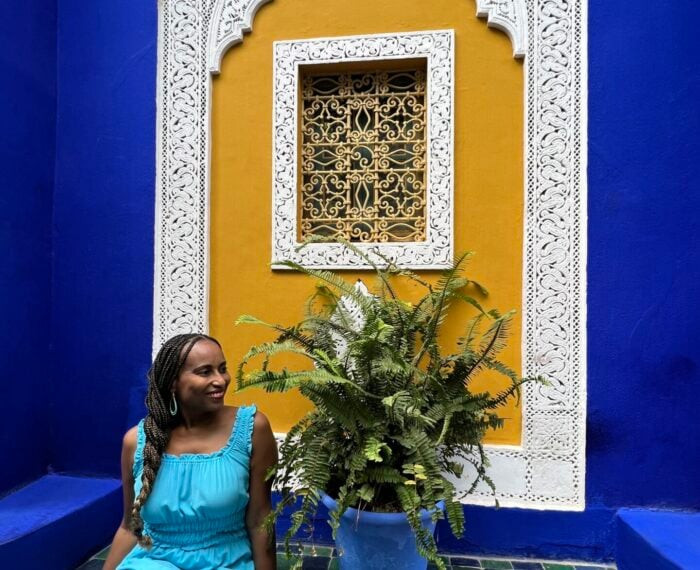 Nadeen at Majorelle Jardin in Marrakech, a highlight for garden lovers during Morocco travel
Nadeen at Majorelle Jardin in Marrakech, a highlight for garden lovers during Morocco travel
Exploring the enchanting Jardin Majorelle in Marrakech, a jewel of Morocco travel.
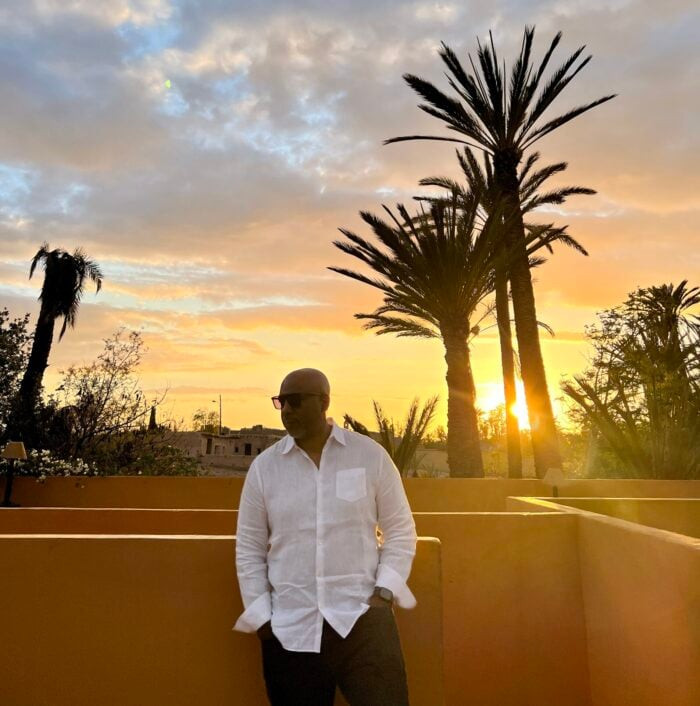 Jnane Tamsna sunset views, a luxurious experience in Marrakech during Morocco travel
Jnane Tamsna sunset views, a luxurious experience in Marrakech during Morocco travel
Enjoying the Moroccan sunset from the rooftop of Jnane Tamsna, a serene moment during Morocco travel.
Sample Itinerary: To experience Morocco’s diversity, consider an itinerary like mine: 1 night Casablanca, 2 nights Fes, 1 night Sahara Desert (Merzouga glamping), 1 night Dades Valley, 3 nights Marrakech. This 8-night itinerary involves significant driving but covers a lot of ground. For shorter trips, focus on one or two cities, with Marrakech being a highly recommended choice for first-time Morocco travel.
Moroccan Food and Drink: A Culinary Journey
Moroccan cuisine is a vibrant tapestry of flavors and aromas, a must-experience aspect of Morocco travel. Spices like turmeric, saffron, and cumin are used generously, creating dishes that are both flavorful and aromatic.
Must-Try Moroccan Dishes:
- Couscous: Morocco’s national dish, typically served with meat and vegetable stew.
- Harira: A hearty soup of tomatoes, lentils, chickpeas, and lamb, traditionally eaten during Ramadan.
- R’fissa: A Casablanca specialty of chicken and lentils served over flaky pancakes.
- Tanjia: A Marrakech slow-cooked meat stew (lamb or veal) prepared in a terracotta jar.
- Tagine: Dishes cooked in a conical clay pot, usually with meat (chicken, lamb, beef) or vegetables, slow-cooked with aromatic spices. Lemon chicken tagine and beef with prunes tagine are popular.
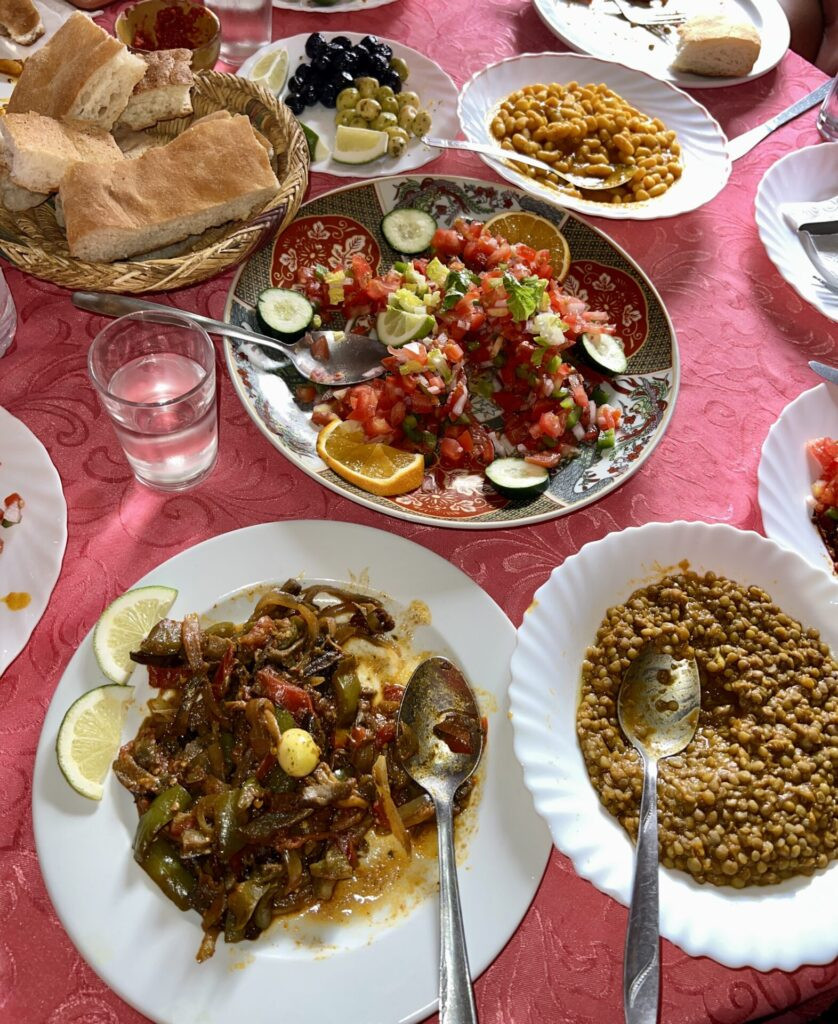 Moroccan food assortments, a culinary delight during Morocco travel
Moroccan food assortments, a culinary delight during Morocco travel
A delicious spread of Moroccan appetizers including beans, vegetables, and bread, typical of a culinary journey through Morocco.
- Pastilla (Bastilla): A sweet and savory pigeon pie (or chicken/seafood), dusted with cinnamon and sugar.
- Zalouk: A flavorful eggplant and tomato dip, often served with bread.
- Gazelle Horns (Kaab el Ghazal): Almond and orange blossom filled pastries.
- Chebakia: Honey-dipped sesame cookies, often enjoyed during Ramadan.
- Msemen & Baghrir: Moroccan pancakes – Msemen are square and layered, Baghrir are known as “thousand-hole pancakes,” both delicious for breakfast with honey or jam.
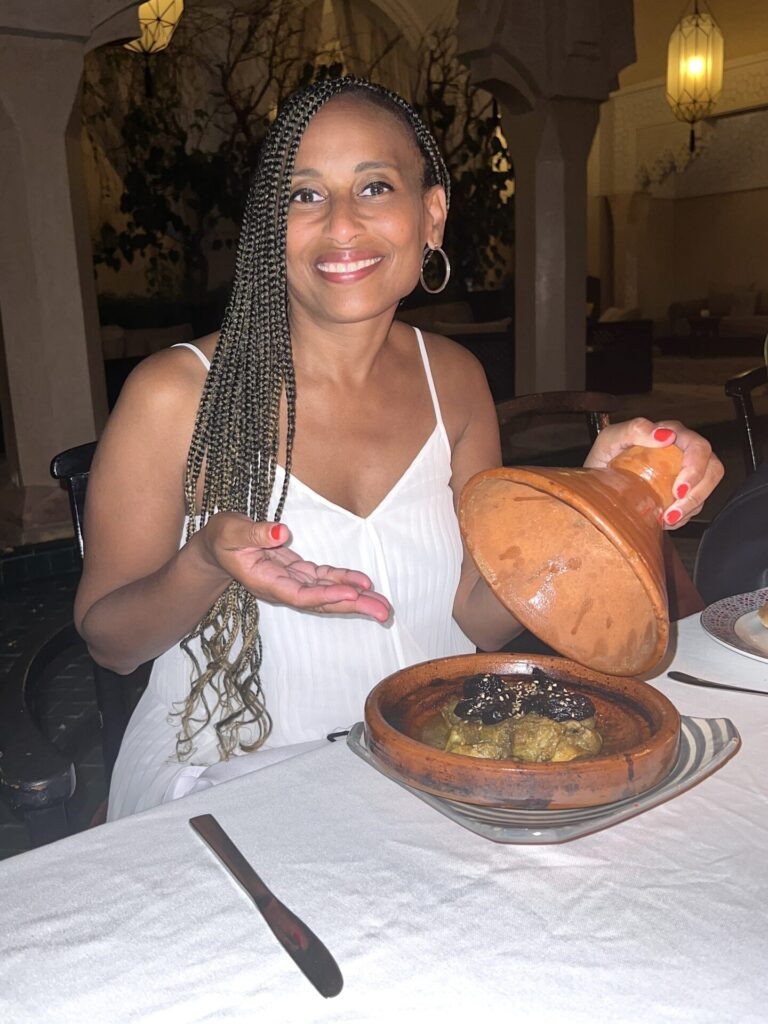 Tagine meal, a staple of Moroccan cuisine during Morocco travel
Tagine meal, a staple of Moroccan cuisine during Morocco travel
Savoring a flavorful Tagine, a quintessential Moroccan dish, during Morocco travel.
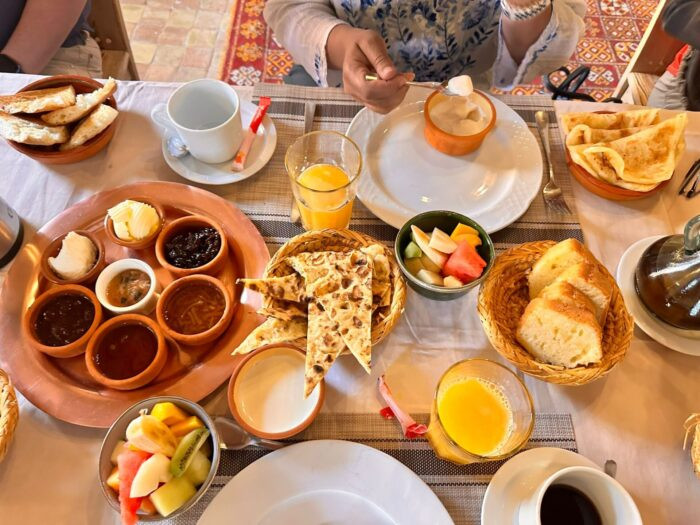 A typical Moroccan breakfast, a delightful start to your day during Morocco travel
A typical Moroccan breakfast, a delightful start to your day during Morocco travel
A traditional Moroccan breakfast spread, featuring breads, pastries, and local delicacies, a treat during Morocco travel.
Moroccan Beverages:
- Mint Tea: The ubiquitous and beloved Moroccan drink, served hot, sweet, and often multiple times a day. It’s a symbol of hospitality and tradition.
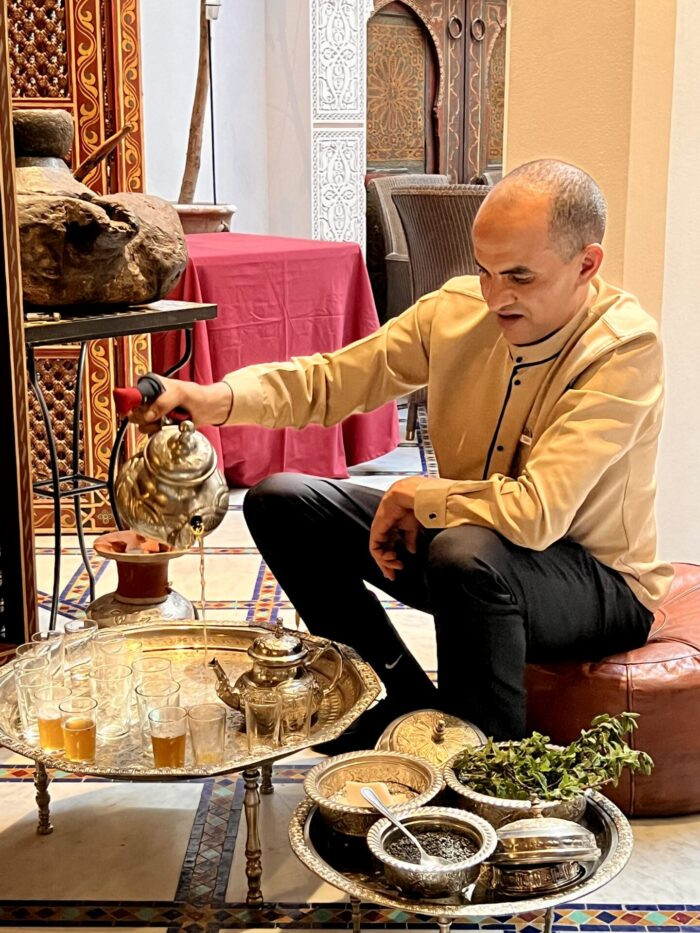 Mint tea preparation, a cultural experience during Morocco travel
Mint tea preparation, a cultural experience during Morocco travel
The ritual of preparing and serving mint tea is an integral part of Moroccan culture and Morocco travel.
Shopping in Morocco: Souks and Treasures
Shopping in Morocco is an experience in itself! From bustling souks to artisan workshops, you’ll find a treasure trove of goods.
- Leather Goods: High-quality leather products like bags, shoes, and jackets are abundant, especially in Fes and Marrakech.
- Carpets and Rugs: Intricately woven Berber carpets are a popular buy.
- Pottery and Ceramics: Colorful and beautifully crafted pottery, tagines, and ceramics are available throughout Morocco.
- Metalwork: Lanterns, mirrors, and decorative metal items showcase Moroccan artistry.
- Spices and Argan Oil: Stock up on fragrant spices and argan oil, a Moroccan beauty staple.
Bargaining is expected in souks, so embrace the haggling culture and enjoy the process!
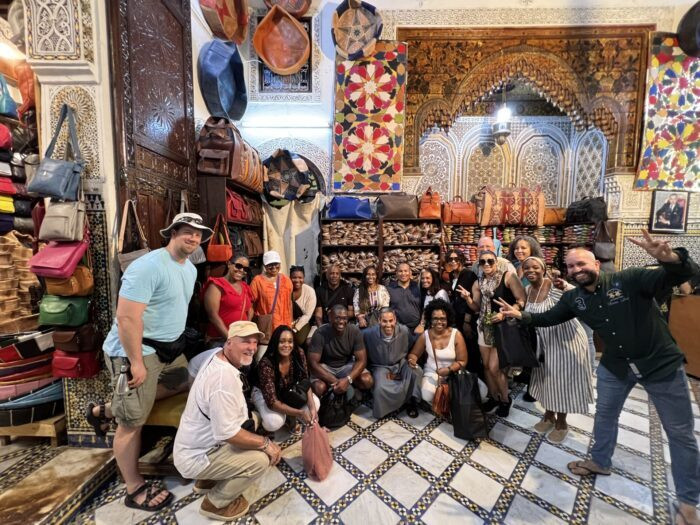 Leather shop in Morocco, showcasing the artisanal crafts available during Morocco travel
Leather shop in Morocco, showcasing the artisanal crafts available during Morocco travel
Exploring a leather shop in Morocco, a shopper’s paradise for unique finds during Morocco travel.
Start Planning Your Morocco Adventure!
Ready to embark on your own Morocco travel experience? With its rich culture, stunning landscapes, and warm hospitality, Morocco promises an unforgettable journey. Start planning your trip today and prepare to be captivated by the magic of Morocco!

